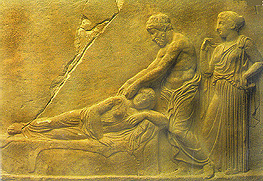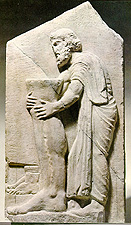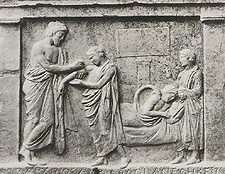In these Asklepia special rites were observed. After purificatory preparation, baths, fasting and sacrifices, the patient would spend the night in the godís precinct or temple, a process known as ďsleeping inĒ (enkoimesis, incubatio).The fashion of incubation seems not to have really caught on until the fourth century when the great healing centers as Cos and Epidauros were established. Thus, we have rational and thaumaturgic medicine, i.e. dream therapy, developing together through the Hellenistic period pari passu, i.e. in equal steps, rather in the manner of astronomy and astrology.During the night as the patient slept, Asclepius would appear to the patient in a dream and give him advice. In the morning the priests would interpret the dream and explain the godís precepts. Patients would thank Asclepius by tossing gold into the sacred fountain and by hanging ex-votos on the walls of the temple.
Relief from Epidauros, 4th Century BCE

In the panel above a temple physician massages a patient's shoulder while a priestess, serving as a nurse, looks on.
Ex-voto from Epdauros, 3rd Century BCE







